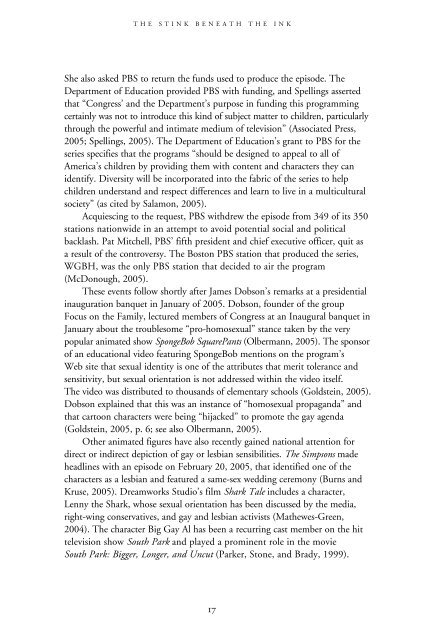2006 - School of Social Service Administration - University of Chicago
2006 - School of Social Service Administration - University of Chicago
2006 - School of Social Service Administration - University of Chicago
Create successful ePaper yourself
Turn your PDF publications into a flip-book with our unique Google optimized e-Paper software.
THE STINK BENEATH THE INK<br />
She also asked PBS to return the funds used to produce the episode. The<br />
Department <strong>of</strong> Education provided PBS with funding, and Spellings asserted<br />
that “Congress’ and the Department’s purpose in funding this programming<br />
certainly was not to introduce this kind <strong>of</strong> subject matter to children, particularly<br />
through the powerful and intimate medium <strong>of</strong> television” (Associated Press,<br />
2005; Spellings, 2005). The Department <strong>of</strong> Education’s grant to PBS for the<br />
series specifies that the programs “should be designed to appeal to all <strong>of</strong><br />
America’s children by providing them with content and characters they can<br />
identify. Diversity will be incorporated into the fabric <strong>of</strong> the series to help<br />
children understand and respect differences and learn to live in a multicultural<br />
society” (as cited by Salamon, 2005).<br />
Acquiescing to the request, PBS withdrew the episode from 349 <strong>of</strong> its 350<br />
stations nationwide in an attempt to avoid potential social and political<br />
backlash. Pat Mitchell, PBS’ fifth president and chief executive <strong>of</strong>ficer, quit as<br />
a result <strong>of</strong> the controversy. The Boston PBS station that produced the series,<br />
WGBH, was the only PBS station that decided to air the program<br />
(McDonough, 2005).<br />
These events follow shortly after James Dobson’s remarks at a presidential<br />
inauguration banquet in January <strong>of</strong> 2005. Dobson, founder <strong>of</strong> the group<br />
Focus on the Family, lectured members <strong>of</strong> Congress at an Inaugural banquet in<br />
January about the troublesome “pro-homosexual” stance taken by the very<br />
popular animated show SpongeBob SquarePants (Olbermann, 2005). The sponsor<br />
<strong>of</strong> an educational video featuring SpongeBob mentions on the program’s<br />
Web site that sexual identity is one <strong>of</strong> the attributes that merit tolerance and<br />
sensitivity, but sexual orientation is not addressed within the video itself.<br />
The video was distributed to thousands <strong>of</strong> elementary schools (Goldstein, 2005).<br />
Dobson explained that this was an instance <strong>of</strong> “homosexual propaganda” and<br />
that cartoon characters were being “hijacked” to promote the gay agenda<br />
(Goldstein, 2005, p. 6; see also Olbermann, 2005).<br />
Other animated figures have also recently gained national attention for<br />
direct or indirect depiction <strong>of</strong> gay or lesbian sensibilities. The Simpsons made<br />
headlines with an episode on February 20, 2005, that identified one <strong>of</strong> the<br />
characters as a lesbian and featured a same-sex wedding ceremony (Burns and<br />
Kruse, 2005). Dreamworks Studio’s film Shark Tale includes a character,<br />
Lenny the Shark, whose sexual orientation has been discussed by the media,<br />
right-wing conservatives, and gay and lesbian activists (Mathewes-Green,<br />
2004). The character Big Gay Al has been a recurring cast member on the hit<br />
television show South Park and played a prominent role in the movie<br />
South Park: Bigger, Longer, and Uncut (Parker, Stone, and Brady, 1999).<br />
17
















